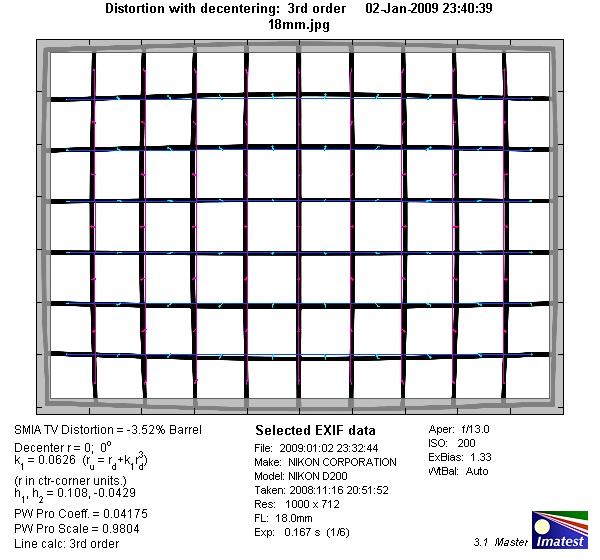|
Nikkor AF-S DX 18-105mm f/3.5-5.6G ED VR - Review / Test Report - Analysis |
|
Lens Reviews -
Nikon / Nikkor (APS-C)
|
|
Page 2 of 3

Distortion
Typical for zoom lenses of this class the AF-S 18-105 VR shows quite pronounced barrel distortion at its shortest focal length. At 24 mm the distortion already flips over to the pincushion type, allthough at a rather moderate level. At 35 mm the amount of pincushion distortion has increased significantly and stays on a rather high level for the rest of focal range.
|
Move the mouse cursor over the focal length text marks below to observe the respective distortion
|
| 18mm |
24mm |
35mm |
50mm |
105mm |
|

|
The chart above has a real-world size of about 120x80cm.
Vignetting
Lenses with reduced image circles designed for APS-C digital SLRs usually show pronounced vignetting at max. aperture. The AF-S 18-105 VR is no exception to this rule with the highest amounts of vignetting visible at the extreme ends of the zoom range. However, with values just below 1EV does better than most other lenses in this class. Wide open at 18mm or 105mm vignetting can be visible (depending on the subject). Stopping down one stop already reduces the issue to a level that's hardly field-relevant.

MTF (resolution)
The lens produced impressive resolution figures in the lab. At 18mm the center and border deliver excellent resolution already at wide open aperture, the extreme borders follow closely with very good resolution throughout the measured aperture range. At 24mm the very high level is maintained. At slightly closed apertures even the extreme borders reach an excellent level. The resolution in the center stays in the excellent range for the whole remaining focal range, only at 105 mm the border resolution drops a little but still gives very good figures.
Please note that the MTF results are not directly comparable across the different systems!
Below is a simplified summary of the formal findings. The chart shows line widths per picture height (LW/PH) which can be taken as a measure for sharpness.
If you want to know more about the MTF50 figures you may check out the corresponding Imatest Explanations
Chromatic Aberrations (CAs)
The level of lateral CAs (color shadows at harsh contrast transitions) is rather high with around or above 1.5px throughout the whole focal and aperture range. CAs can be removed in post processing, though, and some of the newer Nikon DSLRs already do this in camera (if you shoot JPG).

|